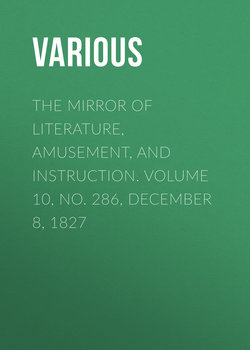Читать книгу The Mirror of Literature, Amusement, and Instruction. Volume 10, No. 286, December 8, 1827 - Various - Страница 2
TEA.—ITS INTRODUCTION INTO ENGLAND
Оглавление(A correspondent, who signs M.M.M. informs us that the article sent to us by P.T.W. and inserted in No. 280 of the MIRROR, was copied verbatim from the Imperial Magazine, a work which we seldom see, and consequently we had no opportunity of ascertaining the origin of our correspondent's paper. It seemed to us a good cyclopaedian article on the subject, and we accordingly admitted it. We now subjoin M.M.M.'s communication.)
In addition to what has been said in the article upon tea, (by P.T.W.) allow me to remark (and which I do not recollect ever to have seen noticed in any work upon the subject) that the seed is contained in two vessels, the outer one varying in shape, triangular, long, and round, according to the number which it contains of what may be termed inner vessels. The outer vessel of a triangular shape, measures, from the base to the apex about three quarters of an inch, and is of a dark brown colour, approaching to black, and thick, strong, and rough in texture; within this is another vessel, containing the kernel; this inner vessel is of a light brown colour, thin, and brittle, in shape, seldom perfectly round, but mostly flat on one side: there are three of them in a triangular seed vessel, two in a long one, and one in that which is round. The kernel is of a brown colour, and in taste very bitter. In no other species of teas than Bohea, is the large kind of seed found, which is probably owing to that species being gathered last or in autumn. There is a small seed found mixed with the Congou kind of teas, about the size of a pea, which is in every respect similar to the large, except in size. This seed was evidently not permitted to ripen, but the calyx of the flower connected with the peduncle is quite perfect. The Twankey species are of the same appearance, all of which I have had ample opportunity of inspecting.
As an appendage to this note, we are induced to quote the following pleasant page from Time's Telescope for 1828; and we take this opportunity of reminding our readers that our customary Supplementary sheet, containing the spirit of this and other popular Annual Works will be published with our next Number.
From a single sheet found in Sir Hans Sloane's library, in the British Museum, and printed by Mr. Ellis in his Original Letters, Second Series, it appears that tea was known in England in the year 1657, though not then in general use. The author of this paper says, "That the vertues and excellencies of this leaf and drink are many and great, is evident and manifest by the high esteem and use of it (especially of late years) among the physicians and knowing men in France, Italy, Holland, and other parts of Christendom; and in ENGLAND it hath been sold in the leaf for six pounds, and sometimes for TEN pounds the pound weight, and in respect of its former scarceness and dearness, it hath been only used as a regalia in high treatments and entertainments, and presents made thereof to princes and grandees, till the year 1657."
Secretary Pepys, in his Diary, vol. i. p. 76, without saying where he had his drink, makes the following entry:—"Sept. 25th, 1660. I did send for a cup of tea (a China drink) of which I never had drunk before, and went away."
In a letter from Mr. Henry Savill to his uncle, Secretary Coventry, dated from Paris, Aug. 12, 1678, and printed by Mr. Ellis, the writer, after acknowledging the hospitalities of his uncle's house, quaintly observes, "These, I hope, are the charms that have prevailed with me to remember (that is to trouble) you oftener than I am apt to do other of my friends, whose buttery-hatch is not so open, and who call for TEA instead of pipes and bottles after dinner; a base unworthy Indian practice, and which I must ever admire your most Christian family for not admitting. The truth is, all nations have grown so wicked as to have some of these filthy customs." In 1678, the year in which the above letter is dated, the East India Company began the importation of tea as a branch of trade; the quantity received at that time amounting to 4,713 lbs. The importation gradually enlarged, and the government, in consequence, augmented the duties upon tea. By the year 1700, the importation of tea had arrived at the quantity of 20,000 lbs. In 1721, it exceeded a million of pounds. In 1816, it had arrived at 86,234,380 lbs. Something more than thirty millions of pounds is probably the present average of importation: some allowance must be made for tea damaged and spoiled upon the passage.—See more on this subject, well worthy of perusal, in Mr. Ellis's Letters, Second Series, vol. iv. pp. 57, et seq.
